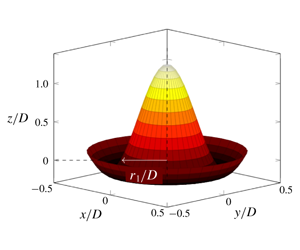Article contents
Buoyancy-driven unbalanced exchange flow through a horizontal opening
Published online by Cambridge University Press: 07 February 2020
Abstract

Buoyancy-driven exchange flows occur in a variety of natural and industrial situations, including nuclear and hydraulic engineering, oceanography and building ventilation. Balanced exchange flows, whereby there is simultaneously an equal volume flux transferred vertically upwards and downwards through a horizontal opening, have previously been described theoretically. However, until now there has been no theoretical description of unbalanced exchange flows, whereby the volume flux in one direction through an opening exceeds that in the other. The model developed herein examines the growth of perturbations on the density interface at an opening made in a horizontal plane that connects buoyant fluid below with denser fluid above. By considering the interface as it is advected away from the plane of the opening by a bulk flow imposed in the vertical, we quantify the exchange for the unbalanced case. The model successfully predicts the Froude number criterion, which corresponds directly to the minimum dimensionless flow rate of the imposed flow, for the onset of unbalanced exchange across circular openings found experimentally. Additionally, comparisons made between the exchanges predicted and measured show excellent agreement across the entire range of possible flows, from unidirectional flow, through unbalanced exchange to balanced exchange. Consideration is given to applications of the model to ocean outfall design and to the prediction of building ventilation flows. For natural ventilation, the theoretical model we derive for unbalanced exchange bridges the gap in the prediction of air flow rates between displacement flows, where the flow is unidirectional, and balanced exchange flows.
Information
- Type
- JFM Papers
- Information
- Copyright
- © The Author(s), 2020. Published by Cambridge University Press
References
- 8
- Cited by

